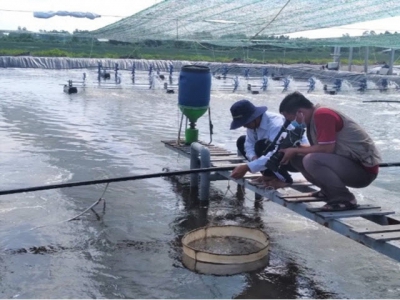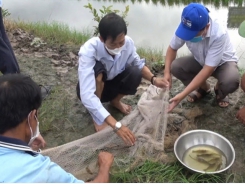Smart shrimp farming solutions to adapt to climate change

Multi-stage farming of white-leg shrimp in tarpaulin-lined ponds is a smart solution to adapt to climate change, applied by farmers with high efficiency.
The multi-stage model of whiteleg shrimp farming in a 500 m2 pond lined with canvas and raising 500 m3 floating lake is a smart farming model, helping farmers be proactive in responding to adverse weather conditions. Photo: Trung Chanh.
On December 10, in Duong Hoa commune, Kien Luong district (Kien Giang province), the Agricultural Extension Center of Kien Giang province held a workshop on the multi-stage model of whiteleg shrimp farming in a 500 m2 pond lined with canvas and raising 500 m3 floating lake.
At the workshop, the delegates assessed that this is a smart farming model, helping farmers be proactive in responding to adverse weather conditions, raising efficiency, achieving high productivity, and bringing good income to farmers.
Mr. Nguyen Van Hien, Deputy Director of Kien Giang Agricultural Extension Center, said that Kien Giang is a province with good conditions to develop a diversified seafood industry, especially brackish shrimp farming.
Kien Giang province identifies brackish water shrimp farming as a strength that needs investment and development. Furthermore, the challenges posed by climate change make proper agricultural transformation essential. In which, the development of shrimp farming brings high economic value.
Kien Giang province's industrial shrimp farming areas are mainly concentrated in districts such as Kien Luong, Giang Thanh, Hon Dat, and Ha Tien city. Many businesses and people have invested in shrimp farming here, with an area of up to thousands of hectares.
Currently, people are gradually switching to high-tech shrimp farming, reducing risks and increasing productivity.
To create favorable conditions for households, the Kien Giang Agricultural Counseling Center has supported the development of a high-tech application of the farming model in ponds/lakes lined with canvas, covered with nets to limit direct sunlight instead of the traditional shrimp farming. The model is implemented in shrimp farming households in Ha Tien city with canvas ponds and Kien Luong district with floating ponds.
Mr. Tran Thanh Kiet, Ta Sang hamlet, Duong Hoa commune, Kien Luong district, is a farmer participating in the model. Mr. Kiet said the model of building ponds/lakes is based on each phase. The rearing pond in phase 1 has a volume of 200 m3 and a circular pond with a volume of 500 m3.
Multi-stage farming will help control technical parameters such as survival rate, feed conversion ratio, well manage water environment, and reduce risks, thereby effectively managing production costs.
"After 70 days of raising shrimp to the size of 40 heads per kilogram, my family's total output is nearly 3.2 tonnes of commercial shrimp per 500 m3 floating pond. The current selling price is VND 130,000 per kilogram; after deducting expenses, the profit is VND 135 million. I am delighted with this profit," said Mr. Kiet excitedly.
Mr. Danh Nhiet, technical officer of the Kien Giang Agricultural Extension Center, shared: "Shrimp farming in several stages will help manage and care of shrimp ponds/lakes more effectively, increasing the survival rate. In addition, shrimp also overgrows, reducing the risk of loss in production."
According to this new model, the first stage of shrimp seed production is stocked at a density of 750 shrimp/m2 in tarpaulin-lined ponds/lakes, covered with 100% nets. Covering net is to minimize radiation from the sun shining directly into the water, helping stabilize the farming area's temperature. After about 25 days of rearing, shrimp were transferred to the second stage of culture in large ponds/lakes (500m2 or 500m3), covered with 50% nets on the total pond surface area and at a density of 300 heads per m2.
During this period, waste collection, as well as control of excess food, is essential. If not collected daily, this amount of waste will accumulate more and more and be a source of toxic gas harmful to shrimp and worsening the living environment of farmed shrimp.
According to the assessment of participating farmers, the industrial shrimp culture model in multi-stage lined ponds minimizes risks, shrimp overgrows, and the survival rate is over 85%. Specifically, after 60 days of culture, shrimp reached a size of about 100 heads per kilogram, and by day 70, shrimp got a size of 40 heads per kilogram.
The model results show that the shrimp productivity in the model is very high (over 63 tonnes per hectare), and the capital turnover time is speedy, capable of farming 3-4 crops each year.
The successful model helps the industrial shrimp farming industry in Long Xuyen city thrive, improve farmed shrimp's productivity, and create more income for farmers and jobs for unskilled workers.
Therefore, farmers want the Agricultural Extension Center of Kien Giang province to continue implementing the model of industrial shrimp farming in many stages with high technology application in the direction of VietGAP, to create attractions and support other households in the area for replicating the model in the following years.
In 2021, Kien Giang province plans to raise brackish water shrimp with an area of 136,000 hectares, with an output of 98,000 tonnes. Intensive and semi-intensive shrimp farming is 4,000 hectares, the output is estimated at 35,000 tonnes. But with positive results, this year may be the year that the province's farmed shrimp production surpasses 100,000 tonnes of commercial shrimp.
Related news
Tools

Phối trộn thức ăn chăn nuôi

Pha dung dịch thủy canh

Định mức cho tôm ăn

Phối trộn phân bón NPK

Xác định tỷ lệ tôm sống

Chuyển đổi đơn vị phân bón

Xác định công suất sục khí

Chuyển đổi đơn vị tôm

Tính diện tích nhà kính

Tính thể tích ao



 Shrimp exports well on the way to recovery
Shrimp exports well on the way to recovery  Sustainable livelihood model for shrimp farmers in Bac…
Sustainable livelihood model for shrimp farmers in Bac…